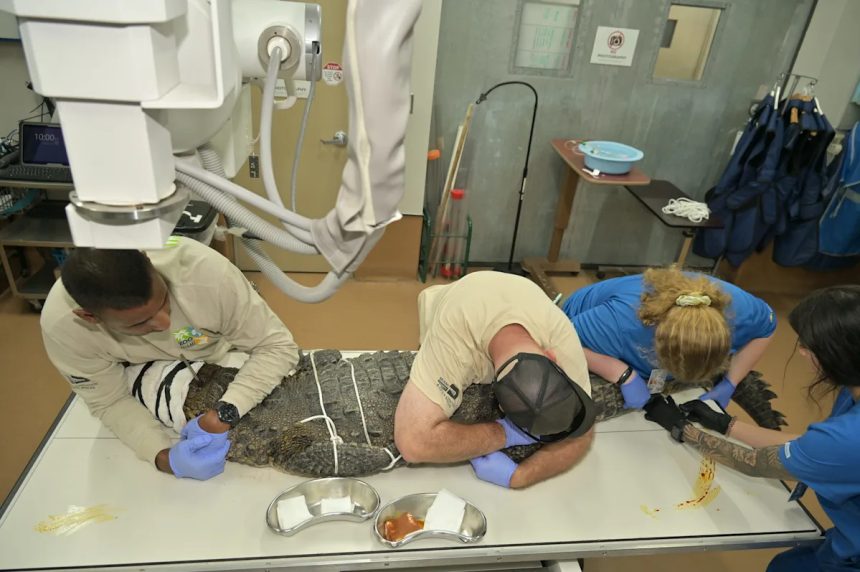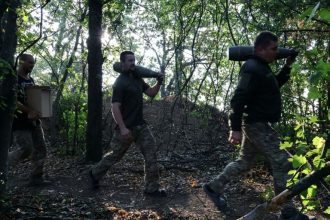An 8-foot American crocodile was found in Key Largo with a spear lodged in the back of its head and a bullet between its eyes Oct. 18.
The Florida Fish and Wildlife Conservation Commission, along with wildlife professionals from Zoo Miami, were able to capture the reptile and transport it to the zoo for treatment.
American crocodiles are listed as a federally threatened species by the U.S. Fish and Wildlife Service. It is illegal to kill or harass American crocodiles under state and federal law.
Here’s what we know.
8-foot crocodile found with spear in its head near Key Largo, Florida
An 8-foot American crocodile was found in Key Largo with a spear lodged in the back of its head and a bullet between its eyes Oct. 18, 2025.
FWC was notified Saturday, Oct. 18, about an injured crocodile in Monroe County, according to Arielle Callender, public information director, south region, Florida Fish and Wildlife Conservation Commission, via email Oct. 22.
Officers spotted an approximately 8-foot American crocodile in Key Largo near mile marker 101 with a spear from a speargun lodged in the back of its head.
“FWC officers and authorized wildlife professionals from Zoo Miami attempted to capture the crocodile for treatment and were initially unsuccessful,” Callender said.
“Thankfully, the crocodile was successfully captured on Monday night (Oct. 20) and transported to Zoo Miami for care.
Zoo Miami successfully removes spear, finds bullet in crocodile’s skull

An 8-foot American crocodile was found in Key Largo with a spear lodged in the back of its head and a bullet between its eyes Oct. 18, 2025.
“Under the leadership of Dr. Gwen Myers, Zoo Miami’s team performed a delicate procedure to remove the spear, which was successfully completed,” according to Cindy Castelblanco, director of marketing and integrated communications with Zoo Miami via email Oct. 22.
“The crocodile was administered fluids, antibiotics, and pain medication and is currently resting and recovering.
“During examination, a bullet was also discovered lodged between her eyes; fortunately, it is not life-threatening at this time.”
The American crocodile is a female and believed to be 10 to 11 years old.
Will injured crocodile be released back into wild?
“This is a wild crocodile that Zoo Miami is assisting FWC with as part of a rescue and rehabilitation effort,” Castelblanco said.
“The goal is to return her to the wild once she has made sufficient progress in her recovery.”
FWC asking for public’s help
FWC investigators are asking for the public’s help to find the person or persons responsible for injuring the crocodile.
Anyone with photos, videos or information is asked to contact the Wildlife Alert Hotline at 888-404-3922. Reports can be made anonymously, and tips that lead to an arrest or citation may be eligible for a reward of up to $1,000.
➤ Fatal bear, alligator attacks happen in same week. List of Florida’s most dangerous animals
What’s the difference between an alligator and a crocodile?

Here’s how to tell the difference between: American alligator, top; American crocodile, middle; and common caiman, bottom.
The FWC explained some of the main differences between an American crocodile and an alligator are:
Crocodile
-
Fourth tooth on lower jaw exposed when mouth is closed
-
Young are light with dark stripes
➤ 9-foot crocodile in Satellite Beach: ‘It kept hiding. It took 4 hours’ to safely remove it
Alligator
-
Only upper teeth exposed when mouth is closed
-
Young are dark with yellow stripes
➤ Alligators in Florida: Top 20 most infested lakes in the state
Caiman
The common or spectacled caiman looks more like the American crocodile than the American alligator, the FWC said. Its color is similar to the crocodile’s but with a shorter more rounded snout.
Caiman are found primarily in freshwater canals and lakes and rarely exceed 5 feet in length.
Where are American crocodiles found in Florida?

Shy and reclusive, the American crocodile can be found in brackish or saltwater areas, ponds, coves, and creeks in mangrove swamps, mostly along the coast in Florida.
Shy and reclusive, the American crocodile can be found in brackish or saltwater areas, ponds, coves, and creeks in mangrove swamps.
“They are occasionally being encountered inland in freshwater areas of the Southeast Florida coast as a result of the extensive canal system,” the FWC said. “Occasionally, crocodiles are encountered inland in freshwater areas along the southern Florida coast.”
Where is Monroe County, Florida?
Monroe County is the southernmost county in Florida and includes all of the Florida Keys.
This article originally appeared on Palm Beach Post: Zoo Miami, Florida officers help crocodile with spear, bullet in head









